Closing a deal is both an art and a science. To be successful, you need to understand the other person’s goals, present a compelling offer, and overcome any objections. Marcus Lemonis will tell you, “The best deals are when both parties that come to an agreement feel just a little uncomfortable.” This means that each side will most likely have to make some compromises in order for the deal to be mutually beneficial and successful. Once you’ve determined what you want to ask for, you have to recognize the right time to ask, and use the best technique to complete the close.

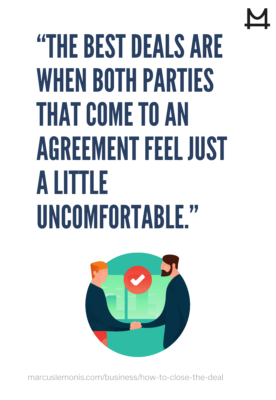
As a business owner, there is always something new to learn about how to close the deal – even if you’ve done so many times in the past. That’s because consumer preferences continue to evolve, and your closing strategies must keep pace.

As your business grows, you may also need to restructure your arrangements with your business partners or investors. Again, the original deal you made with them may no longer be suitable for the future you have in mind. The right closing strategy can help you complete these types of deals, as well as help you close sales with your customers.
Mastering these closing techniques will also help you recruit and retain talented people for your organization. When conducting an interview with a job candidate, for example, you also need to listen closely, make an attractive offer and close the deal.
Regardless of the situation, you should always remember that closing a deal involves a two-way exchange.

Getting a major new client may require hiring more people or increasing your production process. Closing the deal with a new investor may involve giving up a portion of your equity in order to grow, while bringing on a new employee may involve training and extra supervision, at least in the short term. While this article focuses on closing a sale, remember that you can use these techniques in other situations as well.
How to Close the Deal
If you’re wondering how to close the deal, just ask Marcus. Throughout his career, Marcus has closed hundreds of deals involving business owners, customers and investors using a variety of techniques.

To take just one example, Marcus helped mother-daughter owners close a major deal for their French dessert bakery business in northern Georgia. Using his well-known People, Process, Product approach, he introduced them to the executive chef at a leading hotel, reviewed production and pricing issues and closed the deal with delicious cookie samples.
Marcus also helped an Illinois-based pet store owner take her business to a new level of sales. After renaming the business and improving operations, Marcus helped close a deal with a leading pet food ordering and delivery service, expanding the company’s reach to new markets across the country.
Before you can close a deal, you need to prepare the groundwork. Here is a step-by-step strategy for completing a new deal and following up afterwards.
1. Do your research. If you have an interested prospect, you should do your homework before jumping into the sales process. See if you can learn about the goals of the potential customer, as well as current challenges or issues. In a B2B situation, you can study the organization as well as the individual making the purchase decision. If you are selling to consumers, you may need to rely on market research or data from your customer relationship management (CRM) system.
2. Identify the right offer. Next, you want to identify the product or service that is best suited to the needs of your prospect. A fleet transportation company looking for a dozen tractor-trailers will not be interested in your dealership’s SUVs or passenger sedans. Likewise, a consumer shopping for stiletto heels for a night on the town would probably not be interested in casual pajamas.
3. Set expectations. Marcus always says, “People respect you more if they get the truth as opposed to a bunch of fluff.” In presenting the offer, be clear about what your business can provide. That includes the timeframe, as well as the nature of the product or service. Be careful not to over promise and wind up with an unhappy customer. You should also give the prospect a clear picture of how your business works, setting the stage for potential additional sales in the future. Finally, this is an opportunity to show that you care about your prospects and want to earn their trust.
4. Focus on the solution, not the product. While you may be inclined to pitch the latest and greatest features of your product, the prospect will only be interested in hearing about the benefits that are specific to their needs and can help solve their problems. For example, your new software application might run more smoothly than a rival version; but the prospect will be most interested in learning how it can resolve a current issue they are having, such as offering more robust reporting features or tracking inventory.

5. Handle objections. When preparing your pitch, you should also think about how you will handle possible objections from the prospect. There might be concerns about pricing, availability, delivery or product features. Whenever possible, take a proactive approach to these issues, and include them in your presentation or conversational pitch. If the prospect does raise objections along the way, listen carefully and validate those concerns. Then you can calmly point to potential solutions or modify your offer to satisfy the prospect.
6. Ask for the sale. Once you’ve managed the objections and negotiated any remaining issues, it’s time to ask for the sale. In doing so, you should make the prospect feel comfortable about saying “yes” to the deal. In many situations, it’s a good idea to create a sense of urgency by setting a deadline for the prospect to respond.
7. Follow up after the close. It may be tempting to relax after successfully closing a deal, but that’s a mistake. You need to follow up to be sure the product or service was delivered on time, address any further issues, and be sure your new customer is satisfied with everything. Remember that this deal can set the tone for repeat purchases in the future, provided you stay focused on the long-term relationship – not just the immediate transaction.
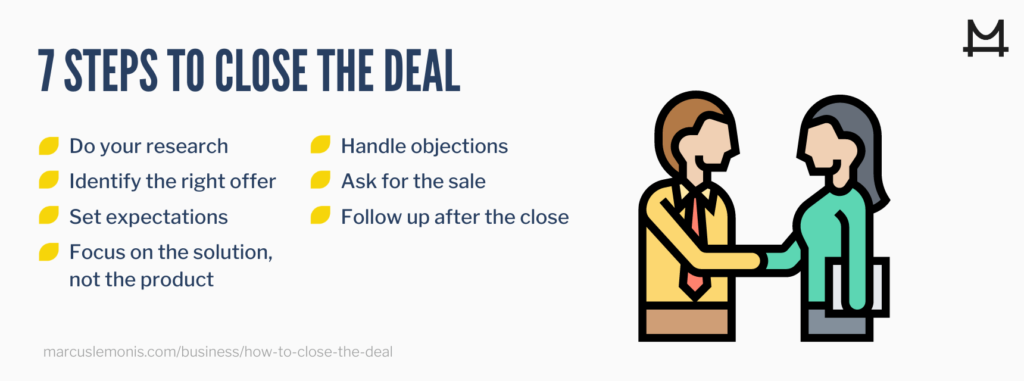
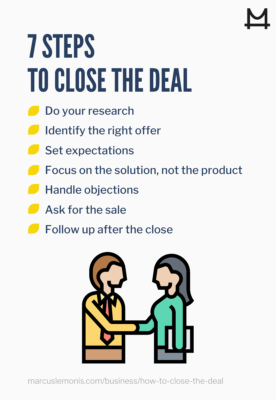
Different Closing Techniques
Many business owners know how to close the deal using one or two favorite techniques. But Marcus recommends expanding your repertoire so you can deal with a wider range of situations. Here are several effective ways you can close your next deal.

- Now or never close. This approach involves making an offer with a special feature or benefit that requires an immediate purchase. On the plus side, it can create a sense of urgency, such as a 24-hour flash sale for an online store. But other prospects might push back, considering this a hard-sell approach, and ask for more time or simply say “no.”
- Question close. With this approach, you ask a leading question to try to close the deal. For instance, “If we could deliver this product tomorrow, would you agree to the sale?” or “What would it take for us to reach a deal today?” It’s a technique that can root out any hidden objections and help you determine how serious the prospect is about closing the deal.
- Summary close. For most deals, this is a less risky approach. Rather than putting the prospect on the spot, you simply repeat the key points of agreement. Then you become collaborators in reaching a deal, rather than standing on opposite sides of the transaction. You can also use this technique to help prospects visualize the benefits they gain by making a purchase.

- Demonstration close. If a prospect seems reluctant to close, offer to demonstrate the effectiveness of your product or service. That’s what Marcus did for the owners of an all-natural household cleaners and soaps company after they pitched a major hotel on their products. He was able to close the sale by offering to clean a bathroom with the company’s products, demonstrating how well they work.
- Sharp angle close. Let’s say the prospect likes your product or service but asks for a price reduction. You can go straight to the closing by saying “yes” and asking them to agree to the deal right on the spot. This can be very effective, provided you’ve done your homework and know you can still make a profit at the lower price point.
- Philanthropic close. Many customers have concerns that go beyond their immediate needs, such as the environment, medical research or social issues.

In these situations, you may be able to close the deal by pointing out how your business is aligned with a particular cause. Even better, you could contribute a percentage of the sale price to the prospect’s designated cause in order to close the deal.
- Sweetener close. If the prospect seems reluctant to commit, try throwing in a sweetener that adds value to the deal. This could be an extra supply of the product, an add-on service or something tailored for the occasion. For instance, Marcus helped married business partners expand their North Florida candy store. .
Because the store was in a low-traffic location, Marcus suggested moving to the Historic Seminole Club, and closed the deal after agreeing to pay for the building renovations.

- Assumptive close. By carefully tracking the prospect’s responses, you may be able to move smoothly from the negotiations right into the closing. Simply take the lead and close the deal with a signature or a new order.
- Soft close. This is the right approach if you sense that the prospect needs more time. Rather than ask for a commitment, you let the prospect think about the purchase, and follow up at a suitable time.
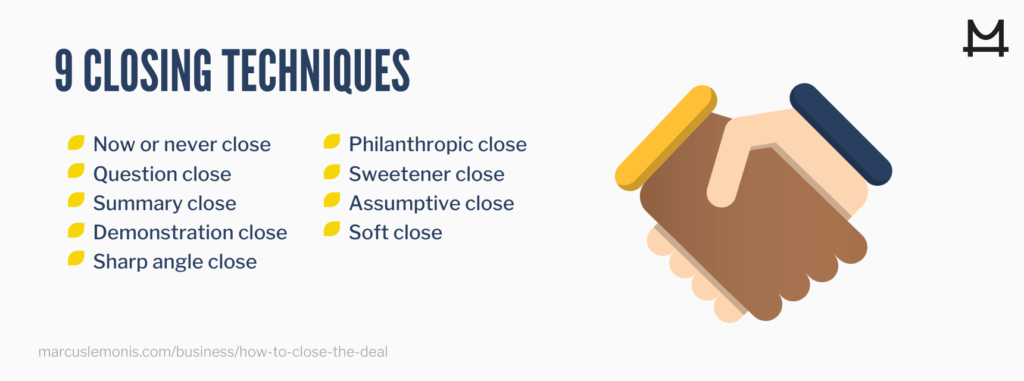
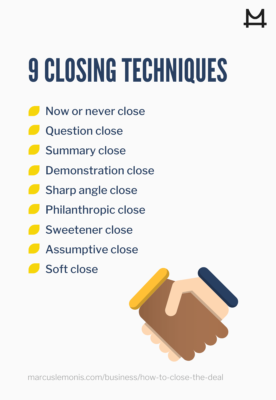
How to Close the Deal
If you want to be successful in sales, then you should be thinking about how to close the deal as soon as you start the process. That includes identifying the prospect’s needs and wants, and crafting an appealing offer that focuses on the benefits you can offer. After negotiating the terms and managing any objections, you can move forward and close the deal using the most appropriate strategy. But always remember that a successful closing is not an ending. Instead, it’s the beginning of a mutually profitable relationship that can help sustain your business for many years in the future.
- How are you going to adjust your closing strategy with this new knowledge?
- Which of the above closing strategies are you going to use?





